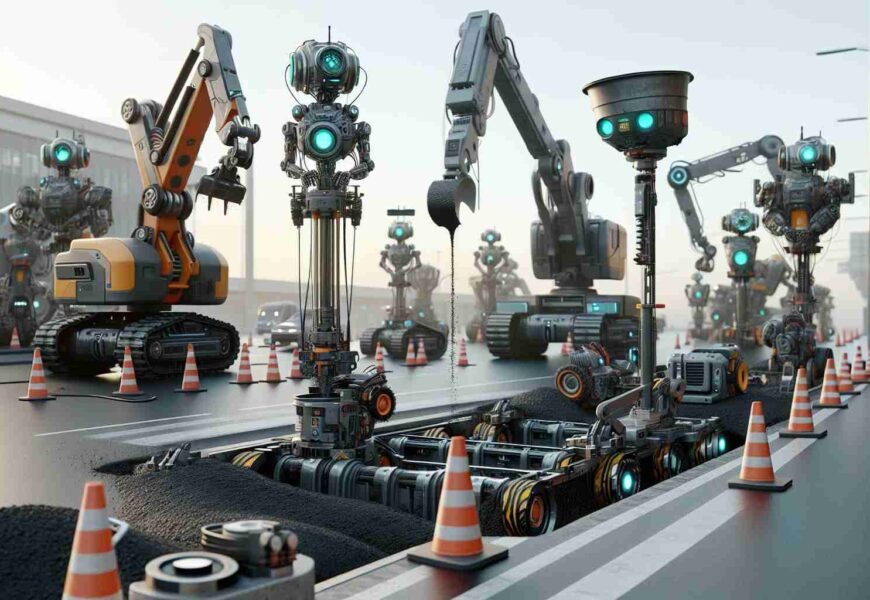Imagine a future where frustrations over potholes are merely a thing of the past, thanks to groundbreaking advancements in road repair technology. Leading the charge in this transformative journey is Robotiz3d, a company spearheading the innovation with its cutting-edge Autonomous Road Repair System (ARRES).
At the heart of ARRES lies the remarkable ARRES Eye, a proactive guardian of road integrity rather than a mere observer. Integrated into various vehicles, this technology conducts thorough scans of road surfaces, pinpointing everything from minor cracks to significant potholes. The crucial data it gathers is swiftly relayed to the core operations for prompt and effective interventions.
Among Robotiz3d’s arsenal is the agile ARRES Prevent—an AI-powered robot capable of autonomously roaming roads or operating under remote guidance to swiftly seal emerging cracks, thwarting the formation of future potholes. Equipped with an automatic transportation system, this robot ensures timely repairs of minor imperfections, preserving the road’s quality and longevity.
But Robotiz3d’s innovation doesn’t end there. The company is also developing ARRES Ultra, a state-of-the-art maintenance device tailored to tackle more substantial street defects. Once deployed, this advanced tool will execute meticulous repairs, including precise filling and cutting of potholes, restoring the road to its optimal condition.
Embracing the ethos of prevention over cure, these technologies are poised to revolutionize equipment maintenance practices and redefine infrastructure upkeep with their efficient, cost-effective solutions. By alleviating the financial strain on local authorities and enhancing the overall user experience, Robotiz3d envisions a global market ripe for embracing this intelligent, systematic approach to road maintenance, paving the way for a future where pothole woes are a distant memory.
Current Market Trends
The emergence of road-repair robots like ARRES from Robotiz3d aligns seamlessly with prevailing market trends that underscore the significance of automation, artificial intelligence, and predictive maintenance. The infrastructure sector is witnessing a shift towards ‘smart cities’ that leverage IoT devices, big data analytics, and AI to proactively manage urban infrastructure, including roads and bridges, to boost efficiency, safety, and sustainability.
Forecasts
Forecasts for the road repair and maintenance market, particularly with automated technologies like ARRES, are optimistic. Analysts project substantial growth driven by increasingly sophisticated AI algorithms, advancements in machine learning, and enhancements in sensor technology. More governmental bodies and local councils are expected to invest in these technologies to avert infrastructure issues and curtail long-term costs.
Key Challenges and Controversies
The adoption of autonomous road repair technology faces significant challenges related to safety and reliability. Operating with precision in dynamic environments alongside human workers and drivers presents a formidable task. Moreover, skepticism and regulatory hurdles from entities resistant to replacing traditional methods with automated solutions pose additional obstacles. Concerns surrounding data security, privacy, and surveillance capabilities further contribute to the ongoing discourse.
Advantages
The advantages of robots like ARRES encompass:
- Cost Efficiency: Reduction in labor expenses and costs associated with extensive road maintenance.
- Preventive Maintenance: Early detection and repair of minor issues before they escalate.
- Enhanced Safety: Decrease in accidents caused by road defects.
- Continuous Operation: Robots can operate round the clock without breaks.
- Minimized Traffic Disruptions: Swift repairs can mitigate disruptions during peak traffic hours.
Disadvantages
Conversely, the drawbacks include:
- High Initial Investment: Upfront costs of acquiring and integrating automated systems may deter some stakeholders.
- Job Displacement: Concerns regarding potential job losses in the road maintenance sector.
- Reliability Concerns: Ensuring robots can navigate real-world road complexities poses challenges.
- Technological Dependency: Maintenance operations may be vulnerable to system reliance or cyber threats.
Websites such as those maintained by the U.S. Department of Transportation or World Highways offer valuable insights and updates on infrastructure and road maintenance technology advancements as cities and nations embrace these futuristic solutions. Staying abreast of industry developments and engaging in discussions on the societal impacts and ethical considerations of these technologies are paramount.










